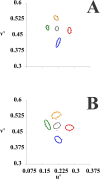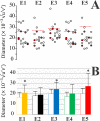Colour Vision Impairment in Young Alcohol Consumers
- PMID: 26465148
- PMCID: PMC4605530
- DOI: 10.1371/journal.pone.0140169
Colour Vision Impairment in Young Alcohol Consumers
Abstract
Alcohol consumption among young adults is widely accepted in modern society and may be the starting point for abusive use of alcohol at later stages of life. Chronic alcohol exposure can lead to visual function impairment. In the present study, we investigated the spatial luminance contrast sensitivity, colour arrangement ability, and colour discrimination thresholds on young adults that weekly consume alcoholic beverages without clinical concerns. Twenty-four young adults were evaluated by an ophthalmologist and performed three psychophysical tests to evaluate their vision functions. We estimated the spatial luminance contrast sensitivity function at 11 spatial frequencies ranging from 0.1 to 30 cycles/degree. No difference in contrast sensitivity was observed comparing alcohol consumers and control subjects. For the evaluation of colour vision, we used the Farnsworth-Munsell 100 hue test (FM 100 test) to test subject's ability to perform a colour arrangement task and the Mollon-Reffin test (MR test) to measure subject's colour discrimination thresholds. Alcohol consumers made more mistakes than controls in the FM100 test, and their mistakes were diffusely distributed in the FM colour space without any colour axis preference. Alcohol consumers also performed worse than controls in the MR test and had higher colour discrimination thresholds compared to controls around three different reference points of a perceptually homogeneous colour space, the CIE 1976 chromaticity diagram. There was no colour axis preference in the threshold elevation observed among alcoholic subjects. Young adult weekly alcohol consumers showed subclinical colour vision losses with preservation of spatial luminance contrast sensitivity. Adolescence and young adult age are periods of important neurological development and alcohol exposure during this period of life might be responsible for deficits in visual functions, especially colour vision that is very sensitive to neurotoxicants.
Conflict of interest statement
Figures





References
-
- WHO. Global status report on alcohol and health 2014 Geneva: World Health Organization (WHO); 2014.
-
- Currie C, Roberts C, Morgan A, Smith R, Settertobulte W, Samdal O, et al. Young people's health in context—health behaviour in school-aged children (HBSC) study: international report from the 2001/2002 survey Copenhagen: WHO Regional Office for Europe; 2004.
Publication types
MeSH terms
Substances
LinkOut - more resources
Full Text Sources
Other Literature Sources
Medical

